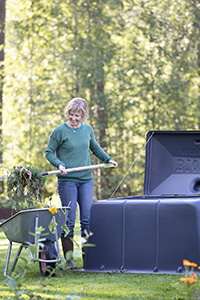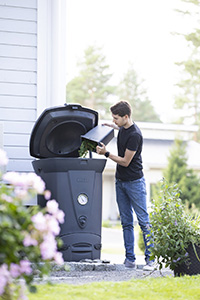What can be placed in the compost?
What can be placed in the compost?
 In a garden compost
In a garden compost
Garden waste, such as
- tree leaves
- vegetable tops
- grass cuttings
- chipped branches and flower stems
- dried weeds
Household bio waste that does not attract rodents, such as
- pot soil and plant residues
- vegetable peels
- remains from cleaning mushrooms or berries
- dust from sweeping
The destruction of diseased plant parts and weed seeds requires heat (usually over 55°C), so they need to be composted exclusively in a well-functioning compost or not at all (see the last chapter). Otherwise, the pathogens may return to the garden in the new soil.
Apples with brown rot, scabby potato tubers, leaves with blight, plants damaged by leaf spot, grey mould or gall mite as well as the parts of currants or gooseberries with maggots or aphides can be placed in the compost without handling.
Branches of currants with gall mite, parts of strawberries with mites, parts of plants with mildew and potatoes with potato blight or virosis can be composted after chipping or covering.
In a kitchen biowaste composter:

All household bio waste, such as
- fruit and vegetable peels
- leftovers of meat or fish and other food waste
- coffee or tea grounds with filter bags
- boiling and rinsing water
- soft and wet papers
- crushed eggshells
- pet excrements
- natural fibres in small pieces
Do not place in the compost
- non-decomposing waste: plastic, glass, rubber, leather
- toxic substances: rot-resistant or disinfecting agents, poisons, paints, solvents, petrol etc.
- vacuum cleaner bags with e.g. glass splinters inside
- cigarette butts or coloured advertising paper with heavy metals
- large amount of paper at one time
- ash or lime, which may make the compost too alkaline
- To avoid risk of spreading, do not place in the compost seeds of couch grass or other perennial weeds, soil or tubers infested by potato-root eelworm, plants damaged by cabbage root fly, onion fly or carrot fly, roots or soil infested by clubroot, onion bulbs with white rot, potatoes with ring rot or waste from root crop cellar in spring.

